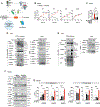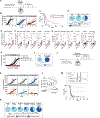A RIPK1-specific PROTAC degrader achieves potent antitumor activity by enhancing immunogenic cell death
- PMID: 38788712
- PMCID: PMC11236506
- DOI: 10.1016/j.immuni.2024.04.025
A RIPK1-specific PROTAC degrader achieves potent antitumor activity by enhancing immunogenic cell death
Abstract
Receptor-interacting serine/threonine-protein kinase 1 (RIPK1) functions as a critical stress sentinel that coordinates cell survival, inflammation, and immunogenic cell death (ICD). Although the catalytic function of RIPK1 is required to trigger cell death, its non-catalytic scaffold function mediates strong pro-survival signaling. Accordingly, cancer cells can hijack RIPK1 to block necroptosis and evade immune detection. We generated a small-molecule proteolysis-targeting chimera (PROTAC) that selectively degraded human and murine RIPK1. PROTAC-mediated depletion of RIPK1 deregulated TNFR1 and TLR3/4 signaling hubs, accentuating the output of NF-κB, MAPK, and IFN signaling. Additionally, RIPK1 degradation simultaneously promoted RIPK3 activation and necroptosis induction. We further demonstrated that RIPK1 degradation enhanced the immunostimulatory effects of radio- and immunotherapy by sensitizing cancer cells to treatment-induced TNF and interferons. This promoted ICD, antitumor immunity, and durable treatment responses. Consequently, targeting RIPK1 by PROTACs emerges as a promising approach to overcome radio- or immunotherapy resistance and enhance anticancer therapies.
Keywords: RIPK1; TLR3; TNF; anticancer immunity; cell death; immunotherapy; inflammation; interferon; necroptosis; radiotherapy.
Copyright © 2024 The Author(s). Published by Elsevier Inc. All rights reserved.
Conflict of interest statement
Declaration of interests The authors declare no competing interests.
Figures







References
Publication types
MeSH terms
Substances
Grants and funding
LinkOut - more resources
Full Text Sources
Molecular Biology Databases
Research Materials
Miscellaneous

